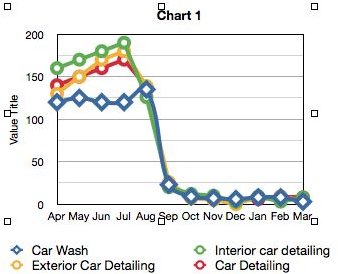The Five Must-Know Phases of a Six Sigma Project Using the DMAIC Processes
The Six Sigma Phases
There are five phases defined in the Six Sigma Methodology. The DMAIC (the acronym for Define, Measure, Analyze, Improve and Control) principle is used in Six Sigma phases to solve both the organizational and the operational issues.
Let us look at each phase in detail with the help of an example.
Phase 1: Define
There are various Six Sigma methodologies to help resolve conflicts and business problems, but unless you know where the problem is, you won’t be able to find the solution. Therefore, defining the problem is critical at this stage.
First Step: Ask yourself two important questions at this point.
- What exactly is the problem?
- How has this problem affected your organization?
Second Step: Create a project plan or a team charter to define the objective of the exercise. Use the data collected from the first step. You can apply a CTQ, (customer to quality) Six Sigma methodology to state the problem. Consider all aspects, including organizational value, finances, resources and overall management strategies. Customer complaints, interviews, surveys and internal feedback are a few methods that are used to record data from all functions.
The project charter should consist of the following:
- Problem statement
- Project statement
- Scope of the project
- Organization’s objectives
- Problem’s influence on these objectives
- Deadlines
- Stakeholders
Third Step: Submit your project charter or a team charter in the form of presentation or an Excel spreadsheet to management and obtain their approval.
Fourth Step: Once the plan is approved, recruit a team of stakeholders from all functions including HR, marketing, sales and finance. This team should be talented enough to use Six Sigma and be able to find solutions to problems.
Once the problem is defined, the team should be able to identify the right Six Sigma strategy to solve the issue. At times, there are situations that may arise where the Six Sigma model will not work at all to solve a specific problem. Remember, implementing Six Sigma process is expensive and time-consuming. Decide at this initial stage itself whether to use the methodology or not to solve particular issues.
Example: A car wash company recently faced a drastic drop in its clientèle and in turn a huge revenue loss. How can this company improve the situation using Six Sigma? The processes can be initiated by implementing the steps provided above.
First Step: The car wash company started the exercise with these two questions.
What is the problem? - The number of clients obtaining the services from the company has gone down
What is the impact? - Revenue loss for the company
Second Step: The car wash company created a project charter using the key data. The company started receiving feedback from its real-time customers and a survey questionnaire is sent to the existing customers. Interviews were also conducted with potential customers. The company used CTQ to prepare a problem statement. A review from the data collected revealed a unique problem for the car wash company and a problem statement is defined at this stage.
Problem Statement: The existing clients are not able to locate the company for subsequent washes. The potential clients with whom the company conducted an interview didn’t even know the company existed.
Project Statement: Identifying solutions to strengthen the clientèle through increasing visibility to the location.
Scope of the Project: Increased clientèle and in turn, revenue growth.
Organization’s Objective: Increase clientèle to achieve revenue growth.
Problem’s influence on these objectives: The location of the company lacks visibility and so clients can’t find the building. The number of clients getting services from the company is going down and there is a huge revenue loss.
Deadline: A solution need to be identified in two weeks. Implement solution in pilot mode on the third week. Implement solution to achieve revenue growth on the fourth and the fifth week. The exercise is expected to be completed in five weeks.
Stakeholders: The clients, employees, management, external vendors and the technical support staff, as required.
Third Step: The project charter in the form of an MS word document is presented to management. Management analyzes the situation.They approve the plan after obtaining assurance from the team about the proposed schedules.
Fourth Step: The team of employees found the root cause of the problem and a suitable solution using Six Sigma Methodology. The team will include a few existing and real-time customers during the process. This team is also responsible for involving external vendors with the required technical skills as and when necessary.
Phase 2: Measure
The DMAIC measure phase helps to gather an incredible amount of information, which can be used to find solutions. There are three key processes involved in this ‘measure’ phase.
Let us look at each one of them in-depth:
Value Stream Mapping: This process illustrates the current position of the problem. Process mapping, or value stream mapping, is usually applied to define the current state of the problem. Create a step-by-step flow chart of the process that needs improvement. Make sure to include the stakeholders responsible for each step in the process. Once the value stream mapping is completed, a team of professionals starts searching for the missing points, wasted areas, constraints and inappropriate or inefficient processes. A brainstorming session is very useful at this stage.
Data Gathering: This process needs to be done very carefully. Do not omit any data related to the problem. Use the 5 Ws (when, what, who, where and why) to address the problem and add this data along with already gathered statistics. Data and statistics should be valid enough to measure the problem. When you have collected the statistics, ask yourself two questions.
1. Are these statistics really related to the problem?
2. Are these statistics fair enough to understand the problem appropriately?
Data Measurement Validation: Now you should focus on validating the measured data. Then gauge repeatability or reproducibility (Gauge R&R) the control charts, time plots and Pareto charts–these are great tools for validation.
If you are validating data pertaining to a specific group or a product, using a time plot is highly beneficial. Control charts are useful in identifying the behavior of a process and producing accurate results with little or no errors.
Example: At this stage, the team of employees from the car wash company moves toward process mapping, data gathering and validation.
Value Steam Mapping: Since company visibility is defined as a problem, the team created a flow chart describing the marketing initiatives and advertising efforts implemented by the company. They also checked whether social media was used in marketing efforts.
Data Gathering: The team started gathering data from employees and clients by asking questions using various methods.
A few sample questions are given below:
- When exactly did the clientèle numbers start to decrease?
- Is there any marketing activity that negatively influenced the company’s value?
- Are the services expensive compared to the competitions?
The team also checked whether these measures are appropriate and good enough to find the solutions by using Six Sigma methodologies.
Data Validation Measurement:
After collecting data, the team started validating the data measured. A control chart was used in validating the collected data. The number of service levels are drawn against each month for the previous year.

It is found that the clientèle started decreasing from the month of October and then went down further in subsequent months_._
Phase 3: Analyze
The DMAIC analyze phase helps to determine the root cause of the problem. Since the define and measure phases are completed, you should now have a clear problem statement. The ‘analyze’ phase is considered the heart of Six Sigma as it helps to determine the root cause of the problem.
The initial step here is to plan the ‘analyze’ phase. Remember, the data collected from the previous phases comes from history, not from the current scenario. Therefore, analyzing data through a methodical strategy is very important. Unless the root cause of the problem is identified accurately, finding a solution to the problem is not feasible.
Methods used in the ‘Analyze’ phase:
DOE (design of experiments): Design of experiments or the DOE method helps to derive a structured solution from multi-variable data. This is a key method used to gain insights into the problem.
<strong>Cause and Effect Analysis</strong>: This analysis process helps to find the hypothesis in a structured way identifying all the possible causes of the problems and its impact on the organization.
FMAE (Failure Modes and Effects): This method helps to identify potential failure areas in the operations and its severity or effectiveness on the organizational system.
Correlation and Regression studies: Using statistical data to analyze related data through a statistical method is known as the correlation and regression study.
At the end of this phase, you will be able to pinpoint the exact cause that affects the outcome of the project, process or a product. The statistical solution to the problem is identified at this phase.
Example: After the ‘Measure’ phase, the team from the car wash company moved on to the ‘analyze’ phase to find the root cause of the problem. A control chart prepared from the collected data showed the decreasing level of clients starting from October and further down in subsequent months.
The team decided to implement a correlation and regression method to find the root cause of the problem. It is found that the potential failure of engaging the clients in certain months caused a heavy revenue loss. One of the key members from the team identified the correlation of the period of declining clientèle with the climatic conditions of the area where the company is located.
A regression analysis is implemented in this situation to confirm the declining client visits during the winter months. Now the team started analyzing what exactly happens during the winter months. After the brainstorming session with existing clients, the team concluded poor lighting in a ‘drive through’ area rendered the company invisible during evening hours. The clients also agreed that most of the time, they were not able to locate the area due to poor lighting.
The root cause of the problem is identified as “Poor lighting system caused invisibility. The clients either went back or searched for a competitor as a result of not being able to locate the company.”
Phase 4: Improve
‘Improve’ is the fourth stage of the DMAIC process in Six Sigma where you start seeing return on your investments. Remember to involve all stakeholders in this phase in order to obtain necessary solutions. Motivate each of them to participate in the brainstorming sessions to obtain as many solutions as possible. Do not omit any idea at this stage.
Develop a list of criteria to be considered while making solutions for improving the situation. Time, cost, and ease of process are the criteria normally used during the improvement phase of the process. Six Sigma tools such as a matrix, DOE (design of experiments), QTC (quality to control) and regression analysis are used while creating solutions to improve the situation. The statistical solution needs to be converted into a practical one during this ‘improve’ phase.
In case of multiple results, key solutions need to be prioritized and used in a piloted manner. The pilot processes indicate the accuracy of the solution identified to improve the situation. Have you seen the solutions working well in the pilot processes? Well, now it is time to implement the findings in the real-time process in order to close this phase. Most of the time, teams get tempted to go back for discussions again to find more solutions. The team leader should control the team appropriately. Repeated meetings will unnecessarily delay the progress.
Example: Now that the root cause of the problem is identified, processes are set to improve the situation at the car wash company. The team contacted external vendors who can fix the lighting issues associated with the company and the building edifice. The cost, time and services related to fixing the lighting are discussed with the vendors. Finally, a skilled and cost-effective vendor is chosen to solve the problem.
Phase 5: Control
Now that the problem is identified and a solution has been found after measuring and analyzing the data, what’s the next step? You cannot leave the project as is without focusing on continuous improvement. Aiming at having continuous improvement is what makes an organization successful. This is why you should use the ‘control’ phase while implementing Six Sigma.
Monitor: Monitoring the processes with the help of support tools and techniques is the primary step in the control phase. Periodic analysis through reports, charts and metrics are very important here.
Documentation: Documentation management is very important for organizational growth. Document processes at every stage and create awareness among teams about the importance of documentation.
Training: Without adequate knowledge and proper training, employees may ignore the new processes. Familiarize the newly implemented processes by organizing awareness programs.
The control phase sets up tools and technicalities to continuously improve the process.
Example: The key point in implementing Six Sigma is to continuously improve the organizational system and its operations. Since the root cause of the problem has been identified and the solution found, it is high time to improve the visibility of the company during the winter months and in the evening hours.
The team decided to implement the ‘control’ phase for the continuous improvement of the car wash company. As a result, the following steps are executed:
- The Team monitored and confirmed that the implementation of the new lighting system provided enough visibility to the clients from long distances.
- A person who is well versed in documentation management is given the responsibility to document the whole process. The entire team of workers and stakeholders are informed of the new lighting system and how it should be managed to give enough visibility to visitors.
- A key person is assigned and trained to always check whether the lights are ignited properly during the gloomy times and in the dark areas. Time checks are recorded periodically to avoid any mistakes.
Presentation to Management

Do not forget to document advantages, best practices and results of implementing a solution to the problem identified. Prepare a presentation and share it with management. This is imperative in order to identify other areas for improvement where these Six Sigma methodologies can be implemented.
Example: The strategic team from the car wash company recorded and presented the results of their project to management. Management appreciated the entire team. One year down the road, the company continued to achieve profits and earn a revenue growth even during the winter months.
References
-
Steve DiIoia, Six Sigma Master Black Belt, “Understanding the Phases of Six Sigma” retrieved at www.insyte-consulting.com
Image Credits:
